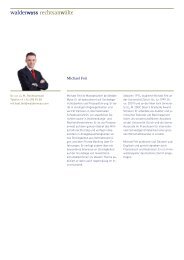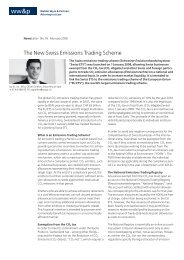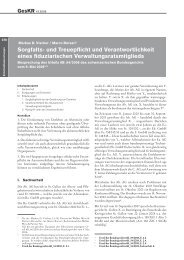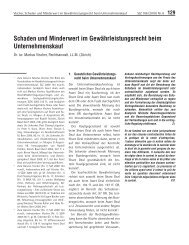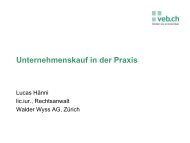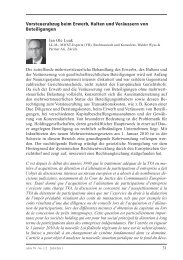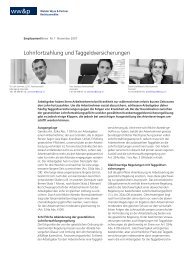Judgment of 7 March 2012 - Walder Wyss Ltd.
Judgment of 7 March 2012 - Walder Wyss Ltd.
Judgment of 7 March 2012 - Walder Wyss Ltd.
Create successful ePaper yourself
Turn your PDF publications into a flip-book with our unique Google optimized e-Paper software.
A-6537/2010<br />
VCLT codified international customary law, those rules may also be applied to conventions<br />
concluded prior to the entry into force <strong>of</strong> the VCLT (judgment <strong>of</strong> the Federal Supreme Court<br />
BGE 122 II 234 cons. 4c) and by countries that have not ratified the VCLT. In accordance with<br />
art 31 VCLT, interpretation must be consistent and based on the wording <strong>of</strong> the treaty provision<br />
seen in the light <strong>of</strong> its usual meaning, the object and purpose <strong>of</strong> the treaty, good faith and the<br />
context. The various elements <strong>of</strong> interpretation have equal status (decision <strong>of</strong> the Federal<br />
Administrative Tribunal BVGE 2010/7 cons. 3.5 with numerous further references; Jean-Marc<br />
Sorel/Valérie Boré Eveno, in: The Vienna Convention on the Law <strong>of</strong> Treaties: A Commentary,<br />
edited by Olivier Corten/Pierre Klein, 2 vols, Oxford/New York 2011, n. 8 ad Art. 31 VCLT<br />
1969). Additional means <strong>of</strong> interpretation are the treaty documentation and the circumstances in<br />
which the treaty was concluded, to which reference may only be made by way <strong>of</strong> confirmation<br />
or clarification <strong>of</strong> an initial interpretation that is unclear or contradictory (art 32 VCLT). The<br />
precept <strong>of</strong> good faith is to be taken as a guiding principle <strong>of</strong> treaty interpretation throughout the<br />
interpretation process (on this entire subject, cf. also [inter alia] decision <strong>of</strong> the Federal<br />
Administrative Tribunal A-4911/2010 <strong>of</strong> 30 November 2010 cons. 4.1 with numerous further<br />
refs; Daniel de Vries Reilingh, Manuel de droit fiscal international, Berne <strong>2012</strong>, n. 109 et seq.).<br />
3.2.1. The starting point for interpretation is the wording <strong>of</strong> the treaty provision. The text <strong>of</strong> the<br />
treaty provision must be interpreted in and <strong>of</strong> itself according to its usual meaning. However,<br />
this usual meaning is to be ascertained in accordance with the context, the object and purpose<br />
<strong>of</strong> the treaty and the principle <strong>of</strong> good faith. According to art 31(4) VCLT, an exception to this<br />
approach may exist where the treaty parties clearly express their joint intention to use a term<br />
not in its usual meaning but in a very specific sense (decision <strong>of</strong> the Federal Administrative<br />
Tribunal BVGE 2010/7 cons. 3.5.1; [inter alia] decision <strong>of</strong> the Federal Administrative Tribunal A-<br />
4013/2010 <strong>of</strong> 15 July 2010 cons. 4.6.2 with numerous further refs.).<br />
3.2.2. Article 31(2) VCLT defines what is meant by the context <strong>of</strong> a treaty provision. Article<br />
31(2). 2 VCLT envisages a narrow interpretation <strong>of</strong> the term ‘context’. In particular, the context<br />
neither includes the circumstances surrounding the conclusion <strong>of</strong> the treaty (for instance, in the<br />
form <strong>of</strong> the preparatory work, which according to art 32 VCLT may be drawn upon for<br />
interpretation purposes only as a subsidiary reference tool; decision <strong>of</strong> the Federal<br />
Administrative Tribunal BVGE 2010/7 cons. 3.5.2) nor elements outside the text itself.<br />
Article 31(3) VCLT then defines those elements constituting the ‘external context’ that may be<br />
taken into consideration for interpretation purposes in the same way as the context. According<br />
to art 31(3)(c) VCLT, any rule <strong>of</strong> international law applicable to the relations between the<br />
contracting states may be factored into the interpretation. There is thus no hierarchy between<br />
art 31(2) and (3) VCLT (decision <strong>of</strong> the Federal Administrative Tribunal BVGE 2010/7 cons.<br />
3.5.4 with numerous further refs.).<br />
3.2.3. The object and purpose <strong>of</strong> a treaty are the objectives which the parties hope to achieve<br />
by concluding the treaty. Article 31 VCLT does not state the sources from which the object and<br />
purpose <strong>of</strong> a treaty may be ascertained. In this regard legal writers generally emphasize the<br />
importance <strong>of</strong> the title and preamble to the treaty (decisions <strong>of</strong> the Federal Administrative<br />
Tribunal BVGE 2010/7 cons. 3.5.2; A-6053/2010 <strong>of</strong> 10 January 2011 cons. 5.1.3; also, Xavier<br />
Oberson, Précis de droit fiscal international, 3rd edn, Berne 2009 [hereinafter: Précis], n. 93).<br />
3.2.4. Where a DTC contains rules modelled on the OECD-MC, it is undisputed in Swiss<br />
literature and court practice that the OECD-MC and its <strong>of</strong>ficial commentaries will carry<br />
substantial weight with regard to interpretation <strong>of</strong> the DTC (Peter Locher, Einführung in das<br />
internationale Steuerrecht der Schweiz, 3rd edn, Berne 2005 [hereinafter: Einführung], p 130;<br />
Oberson, Précis, n. 96–98; <strong>Judgment</strong> <strong>of</strong> the Federal Supreme Court 2A.239/2005 <strong>of</strong> 28<br />
Translation © <strong>Walder</strong> <strong>Wyss</strong> <strong>Ltd</strong>. 12 / 23




